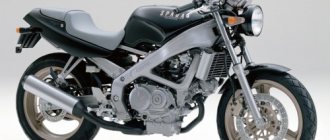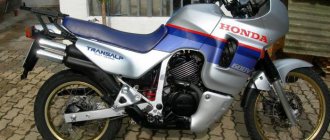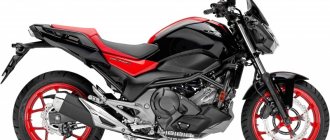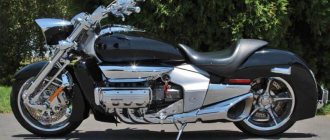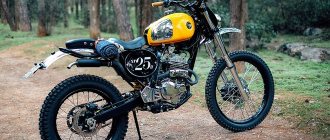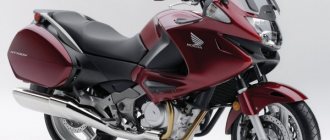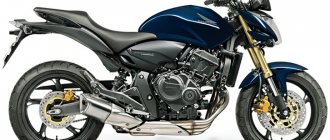The Honda VT 250 Spada road motorcycle model appeared in 1988 and was produced until 1991. The motorcycle is a small-capacity road bike aimed at the markets of Japan, Australia and New Zealand. This model is the progenitor of the Honda VTR 250.
May also be called Honda Spada 250.
The main feature of the Honda VT 250 Spada is a 2-cylinder V-twin liquid-cooled engine that produces 40 hp. power and 25 Nm of torque. The engine is revvy and produces maximum performance at 9000-12000 rpm.
Other features of the Honda VT 250 Spada include an aluminum frame, a 6-speed gearbox, simple suspension in the form of a conventional telescopic fork and a progressive rear monoshock, and disc brakes at the front and rear.
Bike features
Here are the main features of the machine:
- despite the class, the exterior tends to be sporty;
- impressive engine performance, atypical for the category and era;
- significant acceleration starting from 10,000 rpm.
The bike is ambiguous: on the one hand, it is clearly not suitable for connoisseurs of racing cars, and on the other, its power is too great for a simple road classic. However, this is precisely its distinctive feature, which has proven its worth over the years.
Motorcycle Honda VT 250 Spada 1988 review
Technical characteristics of Honda VT 250 Spada 1988
Engine Honda VT 250 Spada 1988
Transmission Honda VT 250 Spada 1988
Dimensions and weights of Honda VT 250 Spada 1988
Chassis and brakes Honda VT 250 Spada 1988
Dynamic characteristics of Honda VT 250 Spada 1988
Other characteristics of Honda VT 250 Spada 1988
Description Honda VT 250 Spada 1988
The Honda VT 250 Spada road motorcycle model appeared in 1988 and was produced until 1991. The motorcycle is a small-capacity road bike aimed at the markets of Japan, Australia and New Zealand. This model is the progenitor of the Honda VTR 250.
May also be called Honda Spada 250.
The main feature of the Honda VT 250 Spada is a 2-cylinder V-twin liquid-cooled engine that produces 40 hp. power and 25 Nm of torque. The engine is revvy and produces maximum performance at 9000-12000 rpm.
Other features of the Honda VT 250 Spada include an aluminum frame, a 6-speed gearbox, simple suspension in the form of a conventional telescopic fork and a progressive rear monoshock, and disc brakes at the front and rear. Average fuel consumption on the Honda VT 250 Spada is 3.5-4 liters. The exact value depends on your riding style. The price for a Honda VT 250 Spada in good technical condition, without mileage in the Russian Federation, is $2000-2500. The cost of models with mileage in the Russian Federation starts from 75,000 rubles.
- 1988 – start of production and sales of the Honda VT 250 Spada model.
- 1991 is the last year of sales of the Honda VT 250 Spada.
The Honda VT 250 Spada is a classic road motorcycle created for the domestic Japanese market, produced, however, only from 1988 to 1991. However, despite the lack of commercial success, this model brought benefit to the company, since, taking into account the experience of its production, another, more popular motorcycle of the same class was subsequently developed - the Honda VTR 250, which is still of interest to many novice motorcyclists, despite the advanced age of all copies.
With its entire appearance, the Honda Spada 250 hints at a “sporty” character. Of course, this is still a small motorcycle, but it is really quite good for its class. The 2-cylinder V-shaped liquid-cooled engine is capable of producing very impressive performance - 40 hp. and 25 Nm of torque, turning the Spada into a very nimble device. The light weight of the motorcycle, which is only 150 kg, also plays an important role.
Externally, the Honda Spada uses a classic style with a touch of sportiness. An elongated and flat gas tank at the top, a round headlight, a dashboard located on the steering wheel in chrome “glasses”, an external frame (alloy!), clip-ons - all this is reminiscent of the Suzuki GSF 250 or Kawasaki Balius 250, which, in fact, are the main competitors of VT 250. The modest size of the motorcycle makes it convenient mainly for short motorcyclists.
To be fair, it should be noted that this bike is not short on speakers. From the bottom, his Honda Spada 250, of course, drives quite reluctantly, asking for the engine to be revved up properly, but at about 10-11 thousand revolutions the motorcycle transforms, accelerating as quickly as you would not expect from it. The six-speed gearbox, like on other Hondas, works perfectly. the lightweight bike reaches speeds of up to 180 km/h, and the VT250 accelerates from 0 to 100 km/h in about 8 seconds.
The suspensions on this motorcycle match the engine - rigid, sporty, short-travel, they allow active maneuvering. The bike readily obeys the steering wheel, and taking sharp turns does not present any difficulties for it, and thanks to the low center of gravity, the weight is practically not felt even in static conditions. But unfortunately, it’s not possible to say such flattering words about the brakes - they clearly skimped on them, installing a single-disc front brake with a two-piston caliper on the front wheel. Considering the good dynamics of the Honda Spada 250, the brakes could have been made better, but according to reviews from owners, they are often not enough, and in addition, they overheat during active driving.
So, what do we have in the bottom line? A lightweight bike with a sports-like riding position, a torquey V-twin that comes to life close to the rev limit, a small 11-litre fuel tank, mediocre brakes and classic looks. Well, the set is quite interesting, considering the low price of the Honda VT 250 on the secondary market. True, it is not easy to find a copy in good condition - the last Spadas were produced a quarter of a century ago, and the high-speed, low-capacity engine cannot boast of a long service life. But if you can find a good Spada, it can be an excellent first motorcycle for a novice urban rider.
Go to the entire range of Honda motorcycles, on this page you can find Honda VT 250 Spada motorcycles from other years of production and information about them
Motorcycles similar in characteristics to the VT 250 Spada:
Showing similar motorcycles with a limit of 5 pieces, see all similar to VT 250 Spada
Price of Honda VT 250 Spada according to advertisements for sale
* Attention! Under the maximum, average and minimum of the Honda VT 250 Spada motorcycle on this page, the average cost according to advertisements for sale on the Internet is indicated, without taking into account the year of manufacture, configuration and generation of the motorcycle model.
Sales statistics of Honda VT 250 Spada by regions of the Russian Federation (in the form of shares)
- Perm region 11.11%
- Rostov region 8.89%
- Astrakhan region 4.44%
- Irkutsk region 4.44%
- Ryazan region 4.44%
- Yaroslavl region 4.44%
- Chelyabinsk region 6.67%
- Moscow region 4.44%
- Moscow 4.44%
- Nizhny Novgorod region. 4.44%
Five random motorcycles:
Five random articles about motorcycles:
To prevent the fork from knocking
How to eliminate play in the front fork rod in the upper bridge On some YAVA motorcycles, after 30 - 50 thousand kilometers, wear leads to play in the front fork rod in the upper bridge. It reveals itself with unpleasant knocking noises when driving on bad roads. Using foil to reduce the gap is ineffective, and tightening the nut does nothing. It was possible to eliminate the backlash using a special nut and a conical ring (Fig. 1). They are made of tool steel (you can, for example, use 40X) with hardening to a hardness of 45 - 50 HRC. We install new parts instead of the round nut, as shown in Fig. 2. When the upper nut is tightened, the split ring opens and tightly fixes the fork rod in the upper bridge. In this case, you do not need to install the lock washer. Rice. 1. Nut (left) and ring. Rice. 2. Mounting unit for the upper bridge: 1 — steering column of the frame; 2 - cone nut: 3 - bridge: 4 - split ring; 5 - nut;.
Troubleshooting Tips for Java Motorcycles
For those who ride Java motorcycles The editors receive many letters from Java motorcycle owners. They ask for advice on troubleshooting problems that appear during operation. The editors turned to experts and are publishing their answers to these questions. The mechanic of the Moscow workshop for warranty repair of Java and Chezet motorcycles, V. T. BOIKO, tells the story. About malfunctions of the clutch mechanism, gearbox and kick-sterter Clutch mechanism. If a correctly adjusted clutch does not engage smoothly, but jerkily, then to determine the defect it is necessary to disassemble the clutch. First of all, remove the left cover. The shift pedal does not need to be removed before this: it should be installed in the gear shift position, and not in the engine start position. The pedal is removed along with the cover and shift shaft (be careful not to lose the release shaft cover). Before removing the cover, drain the oil from the gearbox housing or place the motorcycle on its right side.
Recommendations for owners of heavy motorcycles
I do this. The author of the proposed material is engineer S. NAUMOV from Irbit, an experienced motorcycle tourist who has repeatedly participated in long-distance and difficult test and tourist trips on Ural motorcycles. His recommendations, prompted and tested by experience, will undoubtedly be useful to all owners of heavy motorcycles. And maybe not only them. For ease of presentation, I have divided my proposals by topic. And I'll start with electrical equipment. To facilitate the installation of two series-connected ZMT-6 batteries, you need to cut a 30 mm wide ring from an old motorcycle camera and put it on two cans at once. Or better yet, two such rings, placing them at the top and bottom of the jars. Rice. 1. Connecting the terminals of two batteries with a plate, installing a rubber ring 30 mm wide. I advise you to connect the “+” terminals of one battery and the “-” terminals with another plate made of stainless steel or tinned copper (Fig. 1), and the terminals from which.
Securely fixing the tool box lid on a CZ motorcycle
Reliable locking On CZ motorcycles, the tool boxes are locked with a screw (see picture), which sometimes comes loose while driving (this drawback was noted in the editorial test - “Behind the Wheel”, 1981 No. 1). To get rid of it, I redesigned the retainer. I removed the thread from screw 3 and drilled a hole through in bracket 4 of the cover. I put suitable washers 5 and a spring 6 on the screw, limiting its travel with a cotter pin 7, for which I drilled a hole in the screw. Fixing the tool box lid: a - before alteration; b - after alteration; 1 — box lid; 2 — intake muffler housing; 3 - screw; 4 — cover bracket; 5 — washers; b - spring; 7 - cotter pin. Now, to open the drawer, just pull the screw by the head. Over two years of operation, the spring clamp has proven its advantages over the screw clamp.V. VASILIEV Donetsk region, Kramatorsk 1981N08P41
IZH Planet 3-01, IZH Jupiter 3-01 (3K-01)
More comfortable, more powerful, safer This year the five-millionth machine rolled off the assembly line of the Izhmash motorcycle production association. The motorcycle manufacturing team celebrated this event by switching to the production of modernized models “IZH-Planeta-3-01” and “IZH-Jupiter-3-01”. What's new in them, how are they different? We carried out modernization in three main areas: enhancing active and passive safety, improving ride comfort, and increasing power. Let's start with safety. Both models feature protective arches, a steering-wheel-mounted rear-view mirror, and extended turn signal brackets. Our motorcycles will now be equipped with flip-up passenger footrests to prevent leg injuries. The clutch and front brake control levers have 20mm rubber balls. If the car falls, the motorcyclist no longer runs the risk of being injured by the sharp end of the lever. Modification "IZH&m.
Dimensions and weight
The length of this motorcycle reaches 2010 mm, its width is 715 mm, and its height is 1020 mm. Seat height – 760 mm. The weight of the model is 150 kg, and its tank volume is 11 liters. On average, the VT 250 Spada consumes from 3.5 to 4 liters of fuel per 100 km of road, but this value can vary significantly if the rider's riding style changes.
Review of the Honda VT 250 Spada motorcycle
Honda VT250 Spada
naked model appeared in the Honda line in 1988 and was produced until 1990 inclusive. The motorcycle is a budget model with a V-shaped 2-cylinder engine, an aluminum frame and disc brakes, which was available in the domestic market of Japan and Oceania (particularly Australia).
The model may also have a name - Honda Spada 250
.
The main feature of the Honda VT250 Spada is a 2-cylinder V-shaped (52°) liquid-cooled engine with a volume of 249 cm³ and producing 40 hp. power and 25 Nm of torque. Maximum performance – at 9000-12000 rpm. The engine has 2 camshafts and 4 valves for each cylinder. In addition, the model is equipped with a 6-speed gearbox.
Other features of the Honda VT 250 Spada include an aluminum diagonal frame, simple suspension in the form of a conventional telescopic fork at the front and a progressive monoshock absorber at the rear, disc brakes, an 11-liter fuel tank and 153 kg curb weight.
1990 was the last year of production of the model, after which it disappeared from dealers, and only in 1997 it introduced a new successor - the Honda VTR 250.
The main competitors of the Honda VT 250 Spada in the class:
Content
Brief history of the model
- 1988 – start of production and sales.
Model
: Honda VT 250 Spada (Japan).
Factory designation
: VT250J.
- 1989 – no significant changes.
Model
: Honda VT 250 Spada (Japan, Australia).
Factory designation
: VT250K.
- 1990 – last year of production.
Model
: Honda VT 250 Spada (Australia).
Factory designation
: VT250L.
Photos
Specifications
Technical characteristics of Honda VT 250 Spada:
| Model | Honda VT250 Spada |
| Motorcycle type | naked |
| Year of issue | 1988-1990 |
| Frame | aluminum diagonal |
| engine's type | 2-cylinder, V-shaped (52°), 4-stroke |
| Working volume | 249 cm³ |
| Bore/Stroke | 60.0 x 44.1 mm |
| Compression ratio | 11.0:1 |
| Cooling | liquid |
| Number of valves per cylinder | DOHC chain drive, 4 valves per cylinder |
| Fuel supply system | Carburetor, x2 Keihin, 34.4 mm |
| Ignition type | CDI |
| Maximum power | 40.0 hp (29.4 kW) at 12,000 rpm |
| Maximum torque | 25.0 Nm (2.6 kg*m) at 9000 rpm |
| Clutch | Multi-disc in oil bath, cable drive |
| Transmission | 6-speed |
| type of drive | chain |
| Front tire size | 100/80-17 (52S) |
| Rear tire size | 140/70-17 (66S) |
| Front brakes | 1 disc, 296 mm, 2-piston caliper |
| Rear brakes | 1 disc, 220 mm, 1-piston caliper |
| Front suspension | Telescopic fork 37 mm |
| Rear suspension | Pendulum with monoshock absorber |
| Motorcycle length | 2010 mm |
| Motorcycle width | 715 mm |
| Motorcycle height | 1020 mm |
| Wheelbase | 1380 mm |
| Seat height | 740 mm |
| Minimum ground clearance (clearance) | 150 mm |
| Acceleration to 100 km/h | 8.0 sec. |
| Maximum speed | 180 km/h |
| Gas tank capacity | 11.0 l (including reserve - 2.0 l) |
| Motorcycle weight (dry) | 140 kg |
| Motorcycle weight (curb) | 153 kg |
Fuel consumption
The officially declared fuel consumption for the Honda VT250 Spada is 2.01 liters per 100 km (Japanese calculation method: constant speed 60 km/h, driver + passenger). The exact value depends on your riding style.
The price for a Honda VT 250 Spada in good technical condition, without mileage in the Russian Federation, is $2000-2500. The cost of models with mileage in the Russian Federation starts from 75,000 rubles.
Video
Chassis and brakes
Since the bike has some sporting bent, it is not surprising that the frame is bias-ply and aluminum. It looks, however, very classic, and many modern nakeds have a much brighter sporty hint. The steering wheel and rims here are rather inconspicuous.
The suspension at the rear is a progressive monoshock absorber, and at the front is a 37 mm telescopic fork. The VT 250 Spada brakes using a rear disc with a single-piston caliper and a front disc with a two-piston caliper. The braking system is the main drawback of this model, because the single front disc may not be enough.
Honda VT 250 Spada
Information on the Honda VT 250 Spada motorcycle
Honda VT 250 Spada road motorcycle model
appeared in 1988 and was produced until 1991. The motorcycle is a small-capacity road bike aimed at the markets of Japan, Australia and New Zealand. This model is the progenitor of the Honda VTR 250.
May also be called – Honda Spada 250
.
The main feature of the Honda VT 250 Spada is a 2-cylinder V-twin liquid-cooled engine that produces 40 hp. power and 25 Nm of torque. The engine is revvy and produces maximum performance at 9000-12000 rpm.
Other features of the Honda VT 250 Spada include an aluminum frame, a 6-speed gearbox, simple suspension in the form of a conventional telescopic fork and a progressive rear monoshock, and disc brakes at the front and rear.
The main competitors of the Honda VT 250 Spada in the class:
- Kawasaki Balius 250
- Suzuki GSF 250 Bandit
- Yamaha FZX 250 Zeal
Brief history of the model
- 1988 – start of production and sales of the Honda VT 250 Spada model.
- 1991 is the last year of sales of the Honda VT 250 Spada.
Specifications
| Model | Honda VT 250 Spada |
| Motorcycle type | road (street, naked) |
| Year of issue | 1988-1991 |
| Frame | aluminum diagonal |
| engine's type | 2-cylinder, 4-stroke, V-shaped |
| Working volume | 249 cc cm. |
| Bore/Stroke | 60 x 44.1 mm |
| Compression ratio | 11,0:1 |
| Cooling | liquid |
| Number of valves per cylinder | DOHC, 4 valves per cylinder |
| Fuel supply system | carburetors 2x 32mm Keihin VD10F |
| Ignition type | transistor |
| Maximum power | 40 hp at 12000 rpm |
| Maximum torque | 25.5 Nm at 9000 rpm |
| Transmission | 6-speed |
| type of drive | chain |
| Front tire size | 100/80-17 52S |
| Rear tire size | 140/70-17 66S |
| Front brakes | 1 disc, 296 mm, 2-piston caliper |
| Rear brakes | 1 disc, 1 piston caliper |
| Front suspension | 37 mm telescopic fork, travel – 120 mm |
| Rear suspension | Monoshock absorber with Pro-Link progression (preload adjustment) |
| Maximum speed | 180.0 km/h |
| Acceleration to 100 km/h | 8 sec |
| Dimensions (length x width x height) | 2010 x 715 x 1020 mm |
| Seat height | 760 mm |
| Gas tank capacity | 11 l |
| Motorcycle weight (dry) | 149 kg |
Fuel consumption
Average fuel consumption on the Honda VT 250 Spada is 3.5-4 liters. The exact value depends on your riding style.
The price for a Honda VT 250 Spada in good technical condition, without mileage in the Russian Federation, is $2000-2500. The cost of models with mileage in the Russian Federation starts from 75,000 rubles.
Video
- Brief inspection and launch of the Honda VT 250 Spada motorcycle.
Honda VT 250 Spada
- a classic road motorcycle created for the domestic Japanese market, produced, however, only from 1988 to 1991. However, despite the lack of commercial success, this model brought benefit to the company, since, taking into account the experience of its production, another, more popular motorcycle of the same class was subsequently developed - the Honda VTR 250, which is still of interest to many novice motorcyclists, despite the advanced age of all copies. With its entire appearance, the Honda Spada 250 hints at a “sporty” character. Of course, this is still a small motorcycle, but it is really quite good for its class. The 2-cylinder V-shaped liquid-cooled engine is capable of producing very impressive performance - 40 hp. and 25 Nm of torque, turning the Spada into a very nimble device. The light weight of the motorcycle, which is only 150 kg, also plays an important role.
Externally, the Honda Spada uses a classic style with a touch of sportiness. An elongated and flat gas tank at the top, a round headlight, a dashboard located on the steering wheel in chrome “glasses”, an external frame (alloy!), clip-ons - all this is reminiscent of the Suzuki GSF 250 or Kawasaki Balius 250, which, in fact, are the main competitors of VT 250. The modest size of the motorcycle makes it convenient mainly for short motorcyclists. To be fair, it should be noted that this bike is not short on speakers. From the bottom, his Honda Spada 250, of course, drives quite reluctantly, asking for the engine to be revved up properly, but at about 10-11 thousand revolutions the motorcycle transforms, accelerating as quickly as you would not expect from it. The six-speed gearbox, like on other Hondas, works perfectly. the lightweight bike reaches speeds of up to 180 km/h, and the VT250 accelerates from 0 to 100 km/h in about 8 seconds.
The suspensions on this motorcycle match the engine - rigid, sporty, short-travel, they allow active maneuvering. The bike readily obeys the steering wheel, and taking sharp turns does not present any difficulties for it, and thanks to the low center of gravity, the weight is practically not felt even in static conditions. But unfortunately, it’s not possible to say such flattering words about the brakes - they clearly skimped on them, installing a single-disc front brake with a two-piston caliper on the front wheel. Considering the good dynamics of the Honda Spada 250, the brakes could have been made better, but according to reviews from owners, they are often not enough, and in addition, they overheat during active driving.
So, what do we have in the bottom line? A lightweight bike with a sports-like riding position, a torquey V-twin that comes to life close to the rev limit, a small 11-litre fuel tank, mediocre brakes and classic looks. Well, the set is quite interesting, considering the low price of the Honda VT 250 on the secondary market. True, it is not easy to find a copy in good condition - the last Spadas were produced a quarter of a century ago, and the high-speed, low-capacity engine cannot boast of a long service life. But if you can find a good Spada, it can be an excellent first motorcycle for a novice urban rider.
Honda VT 250 Spada
Brief review of Honda VT 250 Spada
Honda VT 250 Spada is a small-capacity road motorcycle produced at the turn of the 80s - 90s of the last century and sold exclusively in the Japanese domestic market. However, a number of copies of this model still ride on Russian roads, since the motorcycle has excellent endurance, especially for a modest and inexpensive 250 cc model. During the years of its release it was not very popular, but subsequently it was on the basis of the Honda VT 250 Spada that another model was developed - the Honda VTR 250.
The striking difference between the Honda VT 250 Spada and other small-capacity road cars of the same production years lies in the engine - Japanese designers installed a very powerful V-twin in a technologically advanced diagonal frame. Like all souped-up small-capacity motorcycles, the Spada loves high revs, but at the same time it produces excellent power for 250 cc. see working volume characteristics. At the same time, a powerful engine and a well-designed frame are combined with rather primitive suspensions that are not very suitable for an aggressive driving style.
- Yamaha FZX250 Zeal
- Suzuki GSF250 Bandit
- Kawasaki Balius 250
Technical characteristics of Honda VT 250 Spada
- Years of production: 1988-1991
- Class: road
- Frame: diagonal alloy
- Engine: 4-stroke, 2-cylinder, V-shaped
- Engine capacity, cubic meters see: 249
- Cooling: liquid
- Valves per cylinder: 4
- Fuel supply: 2 carburetors
- Power: 40 hp (at 12000 rpm)
- Torque: 25.5 Nm (at 9000 rpm)
- Maximum speed, km/h: 180
- Acceleration from 0 to 100 km/h:
7.5 seconds
- Transmission: 6 – speed
- Wheel drive: chain
- Front tire: 100/80-17
- Rear tire: 140/70-17
- Front brakes: 1 disc, 2-piston caliper
- Rear brakes: 1 disc, 1 piston caliper
- Front suspension: telescopic fork
- Rear suspension: Progressive monoshock with preload adjustment
- Gas tank volume, liters: 11
- Fuel consumption at 110 km/h, liters:
